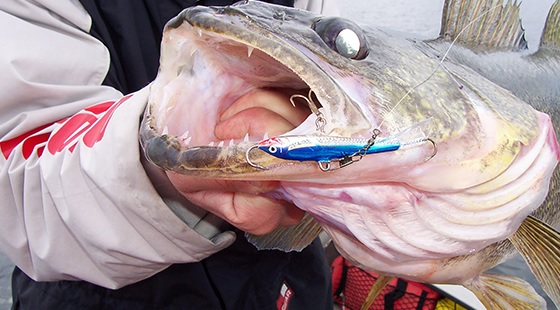It never fails to amaze how many baits flood the market each year, but how few become fish-catching sensations. Fact is, what creates a fish-catching phenomenon is not just the bait but the interpretation of how, when and where the bait should be fished. Case in point, the Rapala® Jigging Rap, which has been around for decades as a go-to ice fishing bait—and would have stayed in hardwater circles had it not been for a few innovative walleye anglers. The word is out, but many anglers are still a bit puzzled …

And Jigging Raps catch more than just walleyes. Smaller #3 and #5 models are aces for panfish, especially during late summer, fall and winter. They’ve taken the bass world by storm, too. Even saltwater anglers are also beginning to harness the power of the erratic-moving bait.
As with most artificial baits, there are myriad ways to fish a Jigging Rap. As a reaction bait, you may need to adjust your stroke to make it look interesting and edible to fish. Some days walleyes may prefer erratic and elusive movements; other days, a more subtle cadence may pay dividends. Experimentation is part of the gig, but ultimately, let the walleyes help you decide.
“Should I troll or cast Jigging Raps?”
Answer is: “all of the above and then some.” Slow trolling with a bow-mount or transom-mount electric motor, casting, or drifting and maneuvering in current are effective ways to fish Jigging Raps.
Slow Trolling with Electric Motor
One of the best ways to fish a Jigging Rap is to locate fish with your electronics and systemically work the area. Sometimes I’ll set the Spot-Lock electronic anchoring function and vertically “bomb drop” to the fish I see on the screen. Other times, I may back-troll into the wind. Whatever you decide, the key is to keep the Jigging Rap in direct relation to the bottom and fish location, so stay under 1 mph, although you can increase trolling speed to cover more water if fish appear to be roaming larger areas.
In terms of how to work the bait, the key is to be deliberate and consistent. Use a three-foot rod motion, starting at 9 o’clock, moving up to 11 o’clock, then returning to a short rest at 9 o’clock. This creates a bird-in-flight bait motion while bringing the bait back to the same depth at the end of each stroke. I keep my rod tip close to the water’s edge for the best feel bait location and potential bites. Many times you’ll simply feel the weight of a fish as you move forward to repeat the stroke, so there’s no need for a power hookset. Given the needle-sharpness of the Jigging Rap’s hooks, a firm pull is all you need.
Casting
Besides fishing vertically or on a slow troll, casting can also be effective. Al Lindner has had great success casting and retrieving Jigging Raps around structure, breaks and shallower flats on a slow troll from the bow while the angler in the rear drags a Jigging Rap.
Fan cast the top and sides of structure. After making a long cast, follow the bait down with your rod tip and leave the bail open until the bait hits bottom. Then close the bail and start your retrieve. You can also cast, close your bail and follow the bait down, which allows you to react immediately. Reeling down to the 9 o’clock position and then pulling up to 11 o’clock is the best way to get the feel of this cast and retrieve presentation. Again, acquiring a cadence takes time, but this is a great way to fish quickly and thoroughly. Remember: When following the bait back down, be ready for a walleye to be there when you come back up. You can also do a kind of sideways retrieve, but casting directly forward and working back seems to be the most effective.
Current
Jigging Raps can also be effective in current areas. Whether anchored up, drifting, or casting, current presents an entirely different scenario. Water motion and speed can impart actions that can’t be created via other retrieves in still waters. One of the most effective methods is to orient the boat upstream of a river hole. Let your Jigging Rap tumble down into the hole, then make successive two- to three-foot rod pulls from deeper water over the upstream hole lip and back to the boat. You may need to experiment with Jigging Rap size to keep the bait in contact with bottom. I often size up to a #9 in current situations.
Size Matters
Jigging Rap size is dictated by water temperature, depth, speed, structure type, location, and forage size. For walleyes, I may use a #5 early in the season or shallow waters, but typically fish a #7, sizing up to a #9 in late summer and fall. As well, if I’m fishing greater depths or increased current, I bring out the #9. As for color, I start with patterns that mimic the forage where I’m fishing. Water clarity can also be a deciding factor. Perch patterns are typically my first choice, but several other colors work equally as well. I can’t emphasize enough that trial and error is key to fishing these magic baits. Play with size, color and cadence to find out what the walleyes want. Don’t give up to early if you’re not getting bit, just change size, color and cadence.
Rods, Reels, and Line
My preferred set-up is a 6’ 8” to 7’ 2” medium-light to medium-power fast-action spinning rod.
When it comes to choosing the right line for Jigging Raps, the monofilament versus braid debate continues. While both have their place, my preferred setup is 10-pound Sufix® Castable Fluorocarbon. The combination of less stretch and near invisibility allows me to fish many situations efficiently. I attach a small #1 barrel swivel approximately three feet above my Jigging Rap to minimize line twist – and attach the other end of the swivel to a three-foot section of 10-pound Sufix monofilament and tie directly to the Jigging Rap, no clip required. What I like about the monofilament leader is it introduces some stretch to the system, which combined with low-stretch fluorocarbon, helps keep fish hooked.
When is the right time to fish braid? I switch to 10-pound (4-pound diameter) Sufix 832® Braid when fishing current or deeper water. 10-4 braid gives me maximum strength while the small line diameter cuts through the water like a knife. Instead of a monofilament leader, I will switch to a 10-pound fluorocarbon leader for more immediate hooksets in deep water. Again, I use a barrel swivel to mitigate line twist, and I tie directly to the Jigging Rap.
The learning curve with new presentations never fails to amaze me, and after years on the water, I’m still learning. While I’m constantly reminded that there are no absolutes in fishing, learning to fish the Jigging Rap has given me a new way to catch fish on just about any body of water at any time of the year.
— Tom Neustrom
